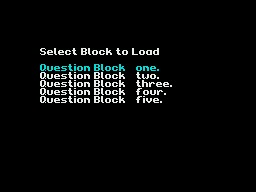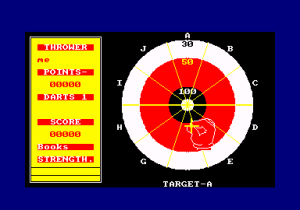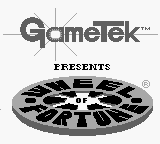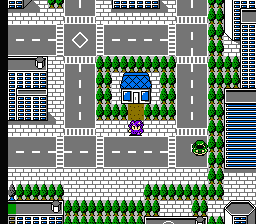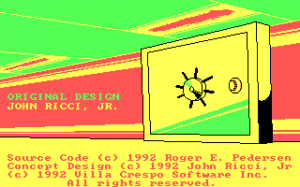Game Classification
Deal or No Deal: Secret Vault Games Cat Daddy Games, 2K Play, 2007
Classification
VIDEO GAMEKeywords
Purpose
Besides play, this title features the following intents:- Licensed title
Market
This title is used by the following domains:- Entertainment
Audience
This title targets the following audience:Age : 12 to 16 years old / 17 to 25 years old
General Public
Gameplay
The gameplay of this title is Game-based(designed with stated goals)
The core of gameplay is defined by the rules below:
Similar games
Loosely based on the game show Deal or No Deal, Secret Vault Games is a selection of minigames based on a money theme. The player can practice any of the games individually, or enter a tournament of five, eight, or 13 randomly-selected games. Each game consists of several rounds, and after each round the player can either lock in his winnings and go on to the next game, or go on the next round, risking all the winnings in that game. Games include:
Wheeler Dealer: Spin the wheel, which has both money amounts and one Bust space on it. Land on a Bust space, and lose everything. Each round consists of multiple spins, and later rounds have more Bust spaces and higher dollar amounts.
Follow the Leader: Starting with a grid of arrows pointing every which way, choose a series of arrows that doesn't cross its own path. Every three moves, the arrows rotate. Once enough moves have been made, the round ends. Higher rounds have a bigger grid, more moves to make, and a bigger reward.
Strike a Deal: In each round, the player starts with $1000, and opens unmarked cases to either add money to his total, subtract money from his total, halve his money, double his money, or get a strike. The contents of the cases are shown to the left, but with no clues as to location. Every five cases, the Banker will make an offer; the player can either take the offer and go on to the next round, or reject the offer and keep playing the round. If three strikes are uncovered in a level, though, the player loses everything. Higher rounds have more strikes on the board, greater rewards, and other types of spaces.
Dropping Dollars: Vaguely similar to a match-3 game, the player's objective is to form dollar amounts (horizontally only) of the same color. Both numbers and dollar signs of various colors will appear at the top of the screen, and the player can drop any that he pleases, causing a different batch of squares to appear. Create a line of the same color, starting with a dollar sign and having at least one digit, and those squares will disappear, adding that amount to the player's total. Match the goal amount for the round, and go on to the next. Don't let the field fill up. Later rounds have a bigger playfield, higher goal, and more colors.
Keys to Success: This game has a grid of buttons that light up different colors. Choose all the buttons of the same color to have them all stay lighted up. Light up all the buttons to go to the next round. Later rounds have a bigger grid. This game is timed, and extra time in one round caries over to the next.
Banker-B-Where?: Similar to minesweeper, this game has a grid, containing both dollar amounts and banker squares. Uncover all squares except the banker squares to go on to the next round. (The player loses if he uncovers a banker.) The dollar amounts get higher when closer to a banker square. Each round has a bigger grid and more banker squares.
Lucky Shuffle: Starting with a grid of cases, each containing a certain amount, move lines of cases such that cases containing an identical amount end up next to each other. When that happens, both cases will be removed from the board, and the player's score will increase. Some cases contain strikes or busts; if three matches of strikes are made in a round, or even one match of busts, the player loses. The contents of cases are shown at the start of each round, and after every match, but it's up to the player to remember where everything was once they close again. Later rounds have more strikes and busts on the board, and greater stakes.
The Gra$$ is Always Greener: Starting with a grid of cases, the player picks one to open, and either keeps it or gives it to the banker. Whoever doesn't get that case instead gets a random unopened case from the grid. After all cases are distributed, the unopened cases are opened, and whoever end up with the most money wins. Later rounds have higher amounts, and the banker starts the round with more money.
Stuck with the Bill: Starting with a grid of numbers, the player and banker take turns picking a number of squares. The objective is to not be the one who picks the last square. In later rounds, the banker plays smarter.
Banker's-a-Square: Based on the pen and paper game Dots and Boxes, the player and the banker take turns placing lines onto a grid. Completing a square allows that player to go again and earns money if the player completed it. The round ends when all squares are filled. The objective is to end the round with more squares than the banker. In later rounds, the field is larger, the banker plays smarter, and the squares are worth more.
High Low: The player picks two unmarked cases from a grid, opens one of them, and then guesses if the other case contains a higher or lower dollar amount. If right, the player earns $25,000. If wrong, he gets one strike. Three strikes, and the player loses. Every four guesses, the banker gives a choice to the player to leave or stay. There is only one round.
Phrase that Pays: Somewhat similar to Hangman, the player starts with money, and buys letters. (Letters are of various costs, depending on how common they are.) If those letters are in the phrase, they are revealed. Otherwise, a letter in the word "BUSTED" is revealed. Either way, the player is out that cash. When the player is ready, he can solve the puzzle, but if he gets it wrong, or if he spells out BUSTED, he loses. When the round is over, any remaining cash is added to the player's total. Later rounds increase the amount of starting money and the amount each letter costs.
Weight and See: Balance a scale containing an unknown weight using various weights. Each time the player places or removes a weight, a guess is used. Match the weight before running out of guesses. Later rounds have fewer guesses to work with.
Dice or No Dice: The player has 3 rolls of the dice to make the best combination possible. Starting with five dice, with a different color on each side, after each roll the player can choose to hold some or all of the dice, then roll the remaining. After three rolls, the possible combinations are highlighted, ranging from the simple (two reds) to the difficult (four different colors). The more difficult matches have higher payout. The twist is that each combination can only be used once, and if there are no combinations to be made, the player loses everything. The dice used have Wild on one side, which can substitute for any color, and Banker on a different side, which cannot be used for anything. After every four matches, the banker makes the player an offer.
Cross the Banker: Similar to the pen and paper game Pipelayer. Starting with two overlaid grids of dots in a field, the player and the banker take turns placing lines, with the player wanting an unbroken path from the top to the bottom, and the banker wanting an unbroken path from the left to the right. Later rounds have a bigger playing field, and larger payouts.
Hunting for Dollars: The player is given a field of spaces, and asked to uncover the dollar amounts. There are a limited number of guesses, and some spots hold strikes. (Three strikes and the player loses.) Later rounds have a bigger playing field, and more strikes.
The Banker's a Snake: Vaguely resembling a turn-based, two player Snake game, this game puts the player and the banker in a field filled with dollar amounts. The player's goal is to move over enough dollar amounts to reach his cash goal, then reach the exit. The banker's goal is to block in the player, using both his tail and the player's to achieve this. Later rounds have a larger playing field, and longer tails.
Moving Forward: Reveal spaces one at a time on a field. Each space has direction arrows in it, and the player can only reveal spaces that the arrows are pointing at. If no moves are possible, the player will get a strike. Three strikes in a round loses. Revealing all the spaces moves the player to the next round. Later rounds have a bigger field and higher rewards.
Pyramid Scheme: Build a pyramid brick by brick from the bottom up. Each brick needs to have a higher value on it than either of the bricks it's sitting on. Later rounds have a bigger pyramid and more blocks to choose from.
Money Market: The player and the banker take turns bidding on three unmarked cases. Whoever has the highest bid wins the contents, but will the contents be worth it? Possible contents are listed to the right. The player wins if he ends up with more money than the banker after all cases are opened. This game only has one round.
[source:mobygames]
Distribution : Retail - Commercial
Platform(s) : PC (Windows)
Wheeler Dealer: Spin the wheel, which has both money amounts and one Bust space on it. Land on a Bust space, and lose everything. Each round consists of multiple spins, and later rounds have more Bust spaces and higher dollar amounts.
Follow the Leader: Starting with a grid of arrows pointing every which way, choose a series of arrows that doesn't cross its own path. Every three moves, the arrows rotate. Once enough moves have been made, the round ends. Higher rounds have a bigger grid, more moves to make, and a bigger reward.
Strike a Deal: In each round, the player starts with $1000, and opens unmarked cases to either add money to his total, subtract money from his total, halve his money, double his money, or get a strike. The contents of the cases are shown to the left, but with no clues as to location. Every five cases, the Banker will make an offer; the player can either take the offer and go on to the next round, or reject the offer and keep playing the round. If three strikes are uncovered in a level, though, the player loses everything. Higher rounds have more strikes on the board, greater rewards, and other types of spaces.
Dropping Dollars: Vaguely similar to a match-3 game, the player's objective is to form dollar amounts (horizontally only) of the same color. Both numbers and dollar signs of various colors will appear at the top of the screen, and the player can drop any that he pleases, causing a different batch of squares to appear. Create a line of the same color, starting with a dollar sign and having at least one digit, and those squares will disappear, adding that amount to the player's total. Match the goal amount for the round, and go on to the next. Don't let the field fill up. Later rounds have a bigger playfield, higher goal, and more colors.
Keys to Success: This game has a grid of buttons that light up different colors. Choose all the buttons of the same color to have them all stay lighted up. Light up all the buttons to go to the next round. Later rounds have a bigger grid. This game is timed, and extra time in one round caries over to the next.
Banker-B-Where?: Similar to minesweeper, this game has a grid, containing both dollar amounts and banker squares. Uncover all squares except the banker squares to go on to the next round. (The player loses if he uncovers a banker.) The dollar amounts get higher when closer to a banker square. Each round has a bigger grid and more banker squares.
Lucky Shuffle: Starting with a grid of cases, each containing a certain amount, move lines of cases such that cases containing an identical amount end up next to each other. When that happens, both cases will be removed from the board, and the player's score will increase. Some cases contain strikes or busts; if three matches of strikes are made in a round, or even one match of busts, the player loses. The contents of cases are shown at the start of each round, and after every match, but it's up to the player to remember where everything was once they close again. Later rounds have more strikes and busts on the board, and greater stakes.
The Gra$$ is Always Greener: Starting with a grid of cases, the player picks one to open, and either keeps it or gives it to the banker. Whoever doesn't get that case instead gets a random unopened case from the grid. After all cases are distributed, the unopened cases are opened, and whoever end up with the most money wins. Later rounds have higher amounts, and the banker starts the round with more money.
Stuck with the Bill: Starting with a grid of numbers, the player and banker take turns picking a number of squares. The objective is to not be the one who picks the last square. In later rounds, the banker plays smarter.
Banker's-a-Square: Based on the pen and paper game Dots and Boxes, the player and the banker take turns placing lines onto a grid. Completing a square allows that player to go again and earns money if the player completed it. The round ends when all squares are filled. The objective is to end the round with more squares than the banker. In later rounds, the field is larger, the banker plays smarter, and the squares are worth more.
High Low: The player picks two unmarked cases from a grid, opens one of them, and then guesses if the other case contains a higher or lower dollar amount. If right, the player earns $25,000. If wrong, he gets one strike. Three strikes, and the player loses. Every four guesses, the banker gives a choice to the player to leave or stay. There is only one round.
Phrase that Pays: Somewhat similar to Hangman, the player starts with money, and buys letters. (Letters are of various costs, depending on how common they are.) If those letters are in the phrase, they are revealed. Otherwise, a letter in the word "BUSTED" is revealed. Either way, the player is out that cash. When the player is ready, he can solve the puzzle, but if he gets it wrong, or if he spells out BUSTED, he loses. When the round is over, any remaining cash is added to the player's total. Later rounds increase the amount of starting money and the amount each letter costs.
Weight and See: Balance a scale containing an unknown weight using various weights. Each time the player places or removes a weight, a guess is used. Match the weight before running out of guesses. Later rounds have fewer guesses to work with.
Dice or No Dice: The player has 3 rolls of the dice to make the best combination possible. Starting with five dice, with a different color on each side, after each roll the player can choose to hold some or all of the dice, then roll the remaining. After three rolls, the possible combinations are highlighted, ranging from the simple (two reds) to the difficult (four different colors). The more difficult matches have higher payout. The twist is that each combination can only be used once, and if there are no combinations to be made, the player loses everything. The dice used have Wild on one side, which can substitute for any color, and Banker on a different side, which cannot be used for anything. After every four matches, the banker makes the player an offer.
Cross the Banker: Similar to the pen and paper game Pipelayer. Starting with two overlaid grids of dots in a field, the player and the banker take turns placing lines, with the player wanting an unbroken path from the top to the bottom, and the banker wanting an unbroken path from the left to the right. Later rounds have a bigger playing field, and larger payouts.
Hunting for Dollars: The player is given a field of spaces, and asked to uncover the dollar amounts. There are a limited number of guesses, and some spots hold strikes. (Three strikes and the player loses.) Later rounds have a bigger playing field, and more strikes.
The Banker's a Snake: Vaguely resembling a turn-based, two player Snake game, this game puts the player and the banker in a field filled with dollar amounts. The player's goal is to move over enough dollar amounts to reach his cash goal, then reach the exit. The banker's goal is to block in the player, using both his tail and the player's to achieve this. Later rounds have a larger playing field, and longer tails.
Moving Forward: Reveal spaces one at a time on a field. Each space has direction arrows in it, and the player can only reveal spaces that the arrows are pointing at. If no moves are possible, the player will get a strike. Three strikes in a round loses. Revealing all the spaces moves the player to the next round. Later rounds have a bigger field and higher rewards.
Pyramid Scheme: Build a pyramid brick by brick from the bottom up. Each brick needs to have a higher value on it than either of the bricks it's sitting on. Later rounds have a bigger pyramid and more blocks to choose from.
Money Market: The player and the banker take turns bidding on three unmarked cases. Whoever has the highest bid wins the contents, but will the contents be worth it? Possible contents are listed to the right. The player wins if he ends up with more money than the banker after all cases are opened. This game only has one round.
[source:mobygames]
Distribution : Retail - Commercial
Platform(s) : PC (Windows)
 Français
Français English
English



